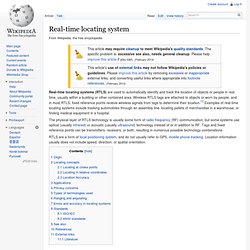

Real-time locating system. Real-time locating systems (RTLS) are used to automatically identify and track the location of objects or people in real time, usually within a building or other contained area.

Wireless RTLS tags are attached to objects or worn by people, and in most RTLS, fixed reference points receive wireless signals from tags to determine their location.[1] Examples of real-time locating systems include tracking automobiles through an assembly line, locating pallets of merchandise in a warehouse, or finding medical equipment in a hospital. The physical layer of RTLS technology is usually some form of radio frequency (RF) communication, but some systems use optical (usually infrared) or acoustic (usually ultrasound) technology instead of or in addition to RF.
Tags and fixed reference points can be transmitters, receivers, or both, resulting in numerous possible technology combinations. RTLS are a form of local positioning system, and do not usually refer to GPS, mobile phone tracking. Origin[edit] Download?doi=10.1.1.24. Khoury%26Kamat.AIC.2009. Java Query : Java, Simply Coded: How to create mobile tracking application?
Free software downloads. Canvg - Javascript SVG parser and renderer on Canvas. Scalable Vector Graphics. Vorlage:Infobox Dateiformat/Wartung/MagischeZahl fehltVorlage:Infobox Dateiformat/Wartung/Standard fehlt Scalable Vector Graphics (SVG, englisch für skalierbare Vektorgrafik) ist die vom World Wide Web Consortium (W3C) empfohlene Spezifikation zur Beschreibung zweidimensionaler Vektorgrafiken.

SVG, das auf XML basiert, wurde erstmals im September 2001 veröffentlicht. Einige der gebräuchlichsten Webbrowser können ohne nachträgliche Installation von Erweiterungen einen Großteil des Sprachumfangs darstellen. Beim Internet Explorer bis Version 8 ist dafür die Installation einer Erweiterung (Plug-in) erforderlich.
Animationen werden von SVG mittels SMIL unterstützt. Da SVG ein XML-basiertes Dateiformat ist, sind Inhalte von SVG-Dateien für computerunterstützte Übersetzung und andere Weiterverarbeitungen leicht zugänglich. Die empfohlene Dateiendung ist .svg oder, wenn die Datei mit gzip komprimiert ist, .svgz. Geschichte[Bearbeiten] Dokument[Bearbeiten] Koordinatensystem und -angabe[Bearbeiten] OpenLayers: Home.
Technical Details. A* Search Algorithm in JavaScript - Brian Grinstead. Note that this code has been updated.

I have an updated blog post detailing what changed. The new source code is available at and the code as of the original post is still available here: View the online demo A* algorithm in JavaScript Why JavaScript? Because it was easy to deploy! Since I know JavaScript pretty well, and most of the examples you can find are in C, Java or a similar language that you cannot run without downloading source code or executables, I thought it would be a good idea to program it on an html page.
My hope was to build a page that could be extended with other search algorithms by separating the UI code (that generates a graph with walls and animates the path that is determined by an algorithm), and the algorithm that finds the path. How? Search.html Just a basic html file that includes jQuery, the excellent JavaScript library, main.css, graph.js, and astar.js. Graph.js astar.js This is the actual implementation of the algorithm. Conclusion.